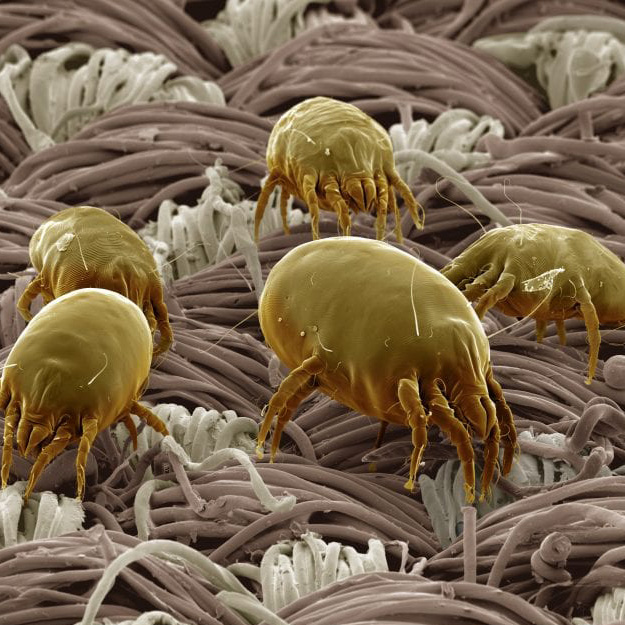Dust mites in YOUR pillow?
Do you (or your child) wake up congested, coughing or sneezing? Or with itchy, scratchy eyes? Do you have sleep apnea? COPD? Do you wake up groggy from a terrible night’s sleep because you couldn’t breathe with a stuffy nose? Or maybe you have chronic nasal congestion.
Your bed pillow may be to blame!
It may be one of the dirtiest articles in your home…
You spend 1/3 of your life with your face pressed into your pillow, breathing in whatever may be lurking there. Things like: dried sweat (we lose about a pint – 500 ml – of moisture every night) and saliva as well as bacteria, viruses, fungi, mold, pollen and more…
And as if that wasn’t gross enough, pillows (and bedding) are loaded with dust mites (pictured above), microscopic creatures that feed on dead skin cells. Their feces contain a substance called DerP1, a potent allergen that can cause allergic reactions (especially in kids) as well as rashes, eczema, sinus problems and asthma.
Dust mite allergies are common – especially in kids
Because dust mite allergy is common among children and is a risk factor (one of many) for developing asthma, keeping bedding as free from dust mites and other contaminants as possible can become a critical health-care decision.
About 25% of Americans have some sort of allergy, and of those, about 66% are allergic to dust mites, according to Dr. James Sublett co-founder and Chief Medical Officer for Family Allergy & Asthma (FAA) and Clinical Professor of Pediatric Allergy and Immunology at the University of Louisville School of Medicine in Louisville, KY.
Good sleep is absolutely critical for all children.
So, if your child isn’t sleeping well, is restless at night, has nightmares, and wakes up with itchy eyes, sneezing, cough or other allergy symptoms, the fastest, drug-free intervention is to wash their pillow and put an anti-allergen cover on it. OR get a new pillow and put an anti-allergen cover on it before using. Washing all their bedding (including pillow cases) weekly is recommended by allergists, especially if a new/clean pillow with an anti-mite/allergen cover isn’t helping enough.
(see links below for the allergist-recommended covers on Amazon)
Want more disgusting facts about your pillow?
A British study found that “up to a third of the weight of your pillow could be made up of bugs, dead skin and house dust mites and their feces.”
A study by Sleepbetter.org found that on average, the sample pillows studied contained more than 300,000 bacterial colonies and more than 100,000 yeast and mold colonies, including some that were toxic to humans.
Another researcher, Duncan Bain, PhD (technical director of Gabriel Scientific, a Dublin, Ireland-based life sciences company that designs and manufactures bedding for hospitals, hotels and homes) said, “If you had to come up with a medium to cultivate bacteria, besides a Petri dish with agar, a pillow is pretty much as good as you can get.”
Why pillows are the ideal medium for mites, bacteria, fungi, mold and more…
Dust mites love warm, humid conditions. Thanks to our breathing, pillows are very humid all night. And when we sweat at night, the moisture penetrates sheets, mattress pads and other bedding, even in a home with low humidity elsewhere, giving even more places for the mites (and other things) to live and breed.
If a pillow gets wet with any sort of liquid (whether spilled juice, drool, urine or vomit) consider tossing it if you can’t wash it immediately or if it is just too soiled. When moisture gets trapped in the pillow it sets up a perfect environment for mold to grow – and mold is a LOT harder to get rid of than dust mites. One way is to soak the pillow with a dilute solution of white vinegar, which can be effective at killing mold spores before you wash. If a down or feather pillow gets wet (or is not completely dried after washing) and develops mold – trash it. You will never get rid of mold once it’s in the feathers.
Treatment to eliminate dust mites:
- Pillows, sheets and other bedding should be washed once a week in hot water, preferably with bleach. Then dry on High for at least 20 minutes. The wash will get rid of accumulated contaminants and pathogens, but it’s the heat of the dryer (130 degrees F, minimum) that kills dust mites.
- You can also kill dust mites (but not other pathogens) by freezing. Put your pillows in the freezer (wrapped in plastic so you don’t contaminate your food!) for 24 – 48 hours. Then vacuum to remove the dead mites (and any other loose contaminants).
- If your pillows are already old, stained or generally gross, toss them and get new ones. Be sure to check the care label for ability to wash and dry the pillow. While ‘organic’ may be tempting, it usually only applies to the covering on the pillow, not what’s inside.
- Now, I’m all in favor of organic, but this is one place where the ability to wash – with bleach if necessary – and dry on high heat is the most important factor to consider. For that reason latex, feather/down or buckwheat shell fillings are not good pillow choices.
- If you DO have a pillow that’s NOT washable, and you don’t want to replace it, AND it can withstand a hot dryer, pop it in the dryer occasionally on high for 20 minutes to control dust mites.
- And finally, researchers writing in the Journal of Allergy and Clinical Immunology reported, “Washing clothing and bedding in water alone, detergent, or detergent plus bleach removed 60% to 83% of the live mites”.
Preventing dust mites:
- Use a wooden or metal bed frame – no upholstered headboards
- Use mite-proof anti-allergen covers that are breathable, not plastic. (see links below for the allergist-recommended covers on Amazon)
Note: If you are looking online, be sure to check the reviews. Covers with a waterproof or plastic component can be hot, crinkly (noisy) and uncomfortable. - Put both mattress and box spring in dust mite-proof covers (called an ‘encasing’)
- Put pillows in mite-proof and allergen proof covers (also called ‘encasing’) and wash the covers weekly
- Wash all bedding (sheets, pillowcases, blankets, duvets, etc.) in hot (130-degree F) water once a week.
- If the sleeper sweats a lot or drools (or is a child who may urinate or vomit in bed), put on a fresh pillow case (and maybe pillow cover) as needed or at least 2-3 times a week.
- You may also need to wash the pillow more often, even if it’s encased in a dust mite- and allergen-proof pillow cover.
- Floors – If possible, have a solid-surface floor in bedrooms (wood, tile, vinyl, etc.). Damp mop at least once a week.
- Carpeting – If there is wall-to-wall carpet in the room that can’t be removed, vacuum at least weekly, when the person who sleeps there (child or adult) is out of the room, using a vacuum with a HEPA filter to eliminate as many allergens as possible.
- Stuffed toys – If a child has stuffed toys, be sure they are washable and can be put in a hot dryer for 20 minutes. Keep stuffed toys off the bed while the child is sleeping. This may be the hardest part of all!
- And, finally, if you let your dog or cat sleep on the bed, you are inviting dust mite re-infestation every night as well as pet dander (another common allergy source, especially for children). Keeping all animals (stuffed and live) off the bed is a must to control potential allergens.
Amazon links for recommended pillow and mattress covers that are anti-mite and anti-allergen.
Click HERE These pillow covers are recommended by leading Allergy Specialists and university Allergy Departments. Designed by a Board-Certified Allergist.
Click HERE for mattress covers they also recommend
Where else do dust mites live?
- Pet beds
- Upholstered furniture
- Carpets
- Draperies
- Clothes
- Stuffed toys
- Fabric-covered items, such as throw pillows
- Blankets (bedding and throw)

